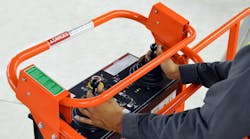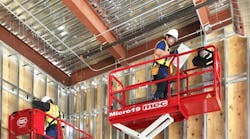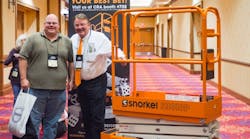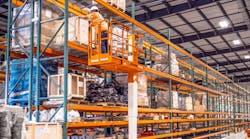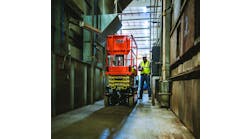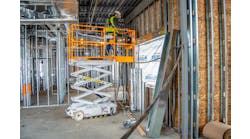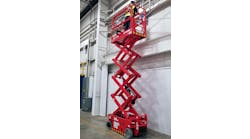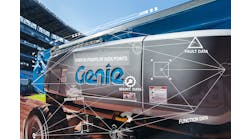RER interviews Snorkel CEO Matthew Elvin about electric scissors, engine-mounted generators on boomlifts, growing international demand for aerial work platforms, the benefits of the upcoming ANSI standards and a lot more.
What are some of the new developments technologically in your company’s equipment during the past year?
At Snorkel, we have recently introduced and unveiled significant technological advancements across a number of our product lines. At ConExpo 2017, we showed a concept design for an all-electric scissor lift, the Snorkel S3019E, which is now in pre-production phase. This innovative design has zero hydraulic hoses anywhere on the lift and has a low step-in height for reduced operator fatigue.
As part of the upgrades to our telescopic mast lift family, we introduced the Snorkel TM12E and TM16E at ConExpo 2017. Both of the new lifts include platform load sensing to comply with various standards, and the TM12E is already in production and available to order. The TM16E will shortly be entering US production.
On our latest line of mid-size telescopic boom lifts, we have introduced proportional throttle, which means that the throttle speed is matched to demand, helping to reduce noise and fuel consumption when only slow speeds are required. We have also introduced engine-mounted generators on this new family of boom lifts, for efficient use of engine power and space.
What trends do you see on the horizon with your company’s equipment, and the industry as a whole?
With ever-increasing noise and emissions regulations, we expect to see a continued increase in demand for electric-driven lifts that comply with these requirements and avoid the complexities associated with diesel engines.
In response to the requirement for increased productivity from within our customer base, we are continuing to see the demand for higher capacity lifts. As demonstrated by our latest line of mid-size telescopic boom lifts, we are already designing our new lines with higher than industry standard capacities. The new Snorkel 660SJ, for example, has an unrestricted lift capacity of 600 pounds. We anticipate that this trend will continue, and as such we are giving greater focus within our research and development process as to how we increase capacity without increasing dimensions and/or weight.
The price of materials is rising with the recent implementation of tariffs from the Trump administration and by other countries in response. How big of an impact will this have on manufacturing and on demand for aerial equipment in the marketplace?
All manufacturers, including ourselves, are closely monitoring the price increases and tariffs, and we are working hard to mitigate increases in pricing to our customers where possible to remain globally competitive. This remains a fluid situation and given the current environment we feel that further changes will result.
Safety continues to be an important topic in the aerial industry. What are some of the new safety developments on your company’s equipment and do you see any new developments on the horizon?
Safety has always been the top priority when it comes to operating machinery and working at heights. With the implementation of our Snorkel Guard secondary guarding system, we wanted to continue to look into more options that provide operators with additional protection, which is why we recently introduced the Snorkel Trigger Guard solution.
The trigger guard solution fits directly onto the joystick and provides an additional level of protection over the enable switch to reduce the likelihood of involuntary movement, without affecting normal operation of the controls.
The trigger guard solution will be fitted as standard to all new Snorkel lifts that have an enable switch operated joystick and is also available as a retrofit solution for legacy Snorkel electric and rough terrain scissor lifts, as well as any Snorkel models with an enable switch operated joystick, including some electric boom lifts, towable booms and mast booms.
Additionally, we unveiled a concept Snorkel Guard secondary guarding solution for scissor lifts at Vertikal Days in the UK earlier this year. Based on positive customer feedback, this is progressing through our development process towards release.
The international demand for aerial equipment continues to grow as people in different countries and industries become more aware of the benefits of aerial equipment. What might be some of the breakthrough areas in usage of aerials in the foreseeable future?
China is certainly the “one to watch” currently, with the rapid development of their equipment rental sector and overall focus on improving working standards across the country. Snorkel has had a presence in this market for many years, and we continue to invest as the market grows. It’s widely thought that China will eventually become one of the most active users of aerial work platforms in the world.
We continue to see increasing aerial equipment adoption across Asia. South Korea is currently a very strong market, but we are also seeing growth in Thailand and Malaysia, amongst others.
New ANSI standards are expected to be published later this year. Can you summarize the impact the new standards will have on the aerial rental industry?
For our rental customers, the new ANSI standards may result in some operational impact initially, as they and their customers get familiar with the changes. As an industry, we need to be mindful of this and ensure that there is sufficient information and training provided to minimize the impact of the possible jobsite outcomes.
We are not anticipating the new ANSI updates to have a drastic effect on the market. One of the most noticeable changes involves the inclusion of platform load sensing on many aerial lifts which helps protect equipment from overloading, saving the rental yard in downtime and repairs. There are mixed feelings from rental companies toward the change, as it does have potential to increase the number of service calls, at least initially. However, this is mostly being viewed as a positive change which can help to protect equipment from overloading, which may result in incidents or equipment damage.
Any other trends you are seeing or expect to see in the aerial rental industry?
Whilst there may be increased commentary on global trade, tariffs and retaliations, we still see an underlying strong demand for aerial equipment in North America, and globally.
